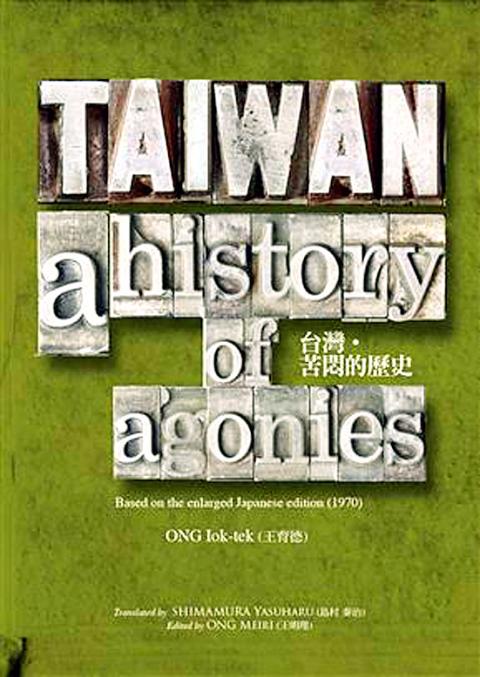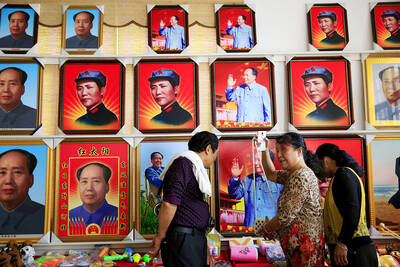Ong Iok-tek’s (王育德) Taiwan: A History of Agonies has finally become available in English. Originally written in Japanese and translated into Chinese, its long-awaited English translation was completed last year. For that reason, Ong (1924—1985) may not be a household name among many in the West who study Taiwanese history, but that does not diminish the valuable insights and contributions of this work.
To place Ong in context, he was born in Taiwan in 1924 during the Japanese colonial era, and was a contemporary of Su Beng (史明, b.1918), a historian and Taiwan independence advocate, former president Lee Teng-hui (李登輝, b. 1923) and democracy pioneer Peng Ming-min (彭明敏, b. 1923), all Taiwanese who studied in Japan.
Parallels can be found between Ong’s book and Su Beng’s 400 Years of Taiwan History. Both books were originally written in Japanese. Su’s 400 Years was written in 1962; Ong’s History of Agonies in 1964. Both were later translated into Chinese and would be instrumental in informing Taiwanese of their past. Ong’s book was translated into Chinese in 1977; Su’s was translated in 1980. Su’s book would further be translated into English in 1986, whereas Ong’s English version was published last year.

Su and Ong both fled to Japan where they moved in different circles. Ong returned to his studies in 1949 and went on to get a doctorate in literature at the University of Tokyo; he would work with developing Taiwan support groups in intellectual and international spheres. Su escaped Taiwan in 1952 and would continue as a revolutionary, training insurgents to return to Taiwan.
Ong’s book is for those researching Taiwanese consciousness post-WWII. What makes it unusual is not just the historical content, much of which can now be found in other contemporary works, but the realization that awareness of Taiwan’s history and identity had reached a state of maturity in Japan by 1964.
Taiwan of course was under martial law and the Chinese Nationalist Party (KMT) controlled most discourse coming out of the nation to the English-speaking world. In 1964, Peng was arrested on charges of treason for his pamphlet Declaration of Formosan Self-Salvation. In the following year, Lee left Taiwan to study for a doctorate at Cornell University.
While in Japan, Ong kept close tabs on Taiwan-related issues, including Peng’s house arrest and later escape. In Ong’s update of 1970, he devotes several pages to Peng’s ideas and flight to Sweden. Ong’s daughter, who helped in making the English version available, stresses that her father’s lifelong aim and pursuit was, “Taiwan is not China. The Taiwanese are not the Chinese. Taiwan should be ruled by Taiwanese themselves.”
Ong’s attention to detail and his ability to draw from Japanese periodicals and other sources are added benefits. Some may be familiar with the Qing Dynasty adage: “an uprising every three years and a revolution every five years.” Ong provides a list for each uprising and revolution, including the year, names of important people and the consequences.
Ong also provides the name, position and background of over a dozen Taiwanese who were targeted and murdered during the 228 Incident and its aftermath, including his brother who was a prosecutor in the Hsinchu District Court. Ong also writes how Taiwanese later were aware that Communist China and the KMT, though at odds, were united in their efforts to suppress any suggestions of Taiwan independence
As Ong spent the final 36 years of his life in Japan, one comes to realize the extent to which Taiwanese consciousness and the support of the independence movement was housed there throughout the 1950s and 1960s. It would later shift to the US in the 1970s and 1980s as more Taiwanese did their graduate studies there. Ong was involved with these different groups and was instrumental in setting up the “Taiwan Youth Society,” which was the forerunner of World United Formosans for Independence.
The book’s preface and final chapter were added by Ong’s daughter to take it well beyond Ong’s 1970 update. She also adds a timeline which ends with the KMT’s overwhelming loss in the November 2014 nine-in-one elections.
The translation reads extremely well. Since most of the book was written in 1964 and updated in 1970, the work uses the Wade-Giles system of Romanization. One can also expect a few discrepancies in historical dates and perceptions that would be cleared up in later decades as more information became available.

Taiwan can often feel woefully behind on global trends, from fashion to food, and influences can sometimes feel like the last on the metaphorical bandwagon. In the West, suddenly every burger is being smashed and honey has become “hot” and we’re all drinking orange wine. But it took a good while for a smash burger in Taipei to come across my radar. For the uninitiated, a smash burger is, well, a normal burger patty but smashed flat. Originally, I didn’t understand. Surely the best part of a burger is the thick patty with all the juiciness of the beef, the

The ultimate goal of the Chinese Communist Party (CCP) is the total and overwhelming domination of everything within the sphere of what it considers China and deems as theirs. All decision-making by the CCP must be understood through that lens. Any decision made is to entrench — or ideally expand that power. They are fiercely hostile to anything that weakens or compromises their control of “China.” By design, they will stop at nothing to ensure that there is no distinction between the CCP and the Chinese nation, people, culture, civilization, religion, economy, property, military or government — they are all subsidiary

This year’s Miss Universe in Thailand has been marred by ugly drama, with allegations of an insult to a beauty queen’s intellect, a walkout by pageant contestants and a tearful tantrum by the host. More than 120 women from across the world have gathered in Thailand, vying to be crowned Miss Universe in a contest considered one of the “big four” of global beauty pageants. But the runup has been dominated by the off-stage antics of the coiffed contestants and their Thai hosts, escalating into a feminist firestorm drawing the attention of Mexico’s president. On Tuesday, Mexican delegate Fatima Bosch staged a

Would you eat lab-grown chocolate? I requested a sample from California Cultured, a Sacramento-based company. Its chocolate, not yet commercially available, is made with techniques that have previously been used to synthesize other bioactive products like certain plant-derived pharmaceuticals for commercial sale. A few days later, it arrives. The morsel, barely bigger than a coffee bean, is supposed to be the flavor equivalent of a 70 percent to 80 percent dark chocolate. I tear open its sealed packet and a chocolatey aroma escapes — so far, so good. I pop it in my mouth. Slightly waxy and distinctly bitter, it boasts those bright,